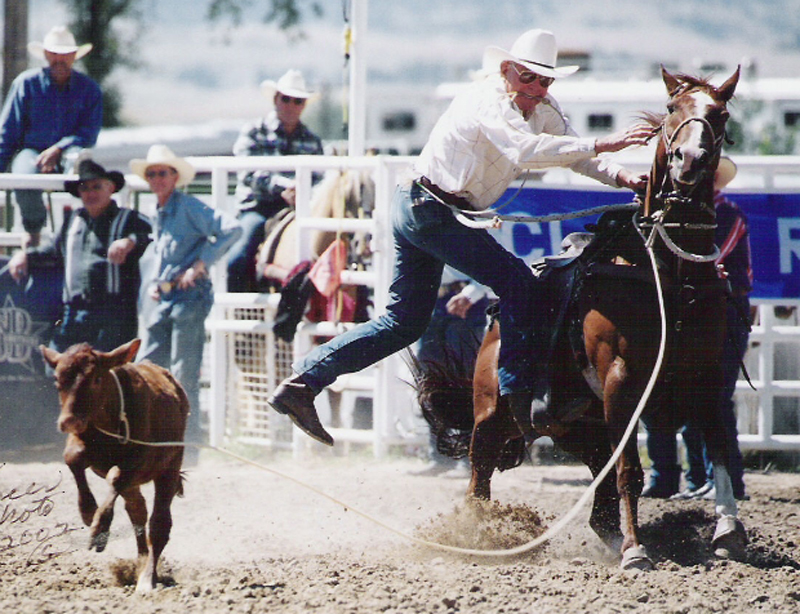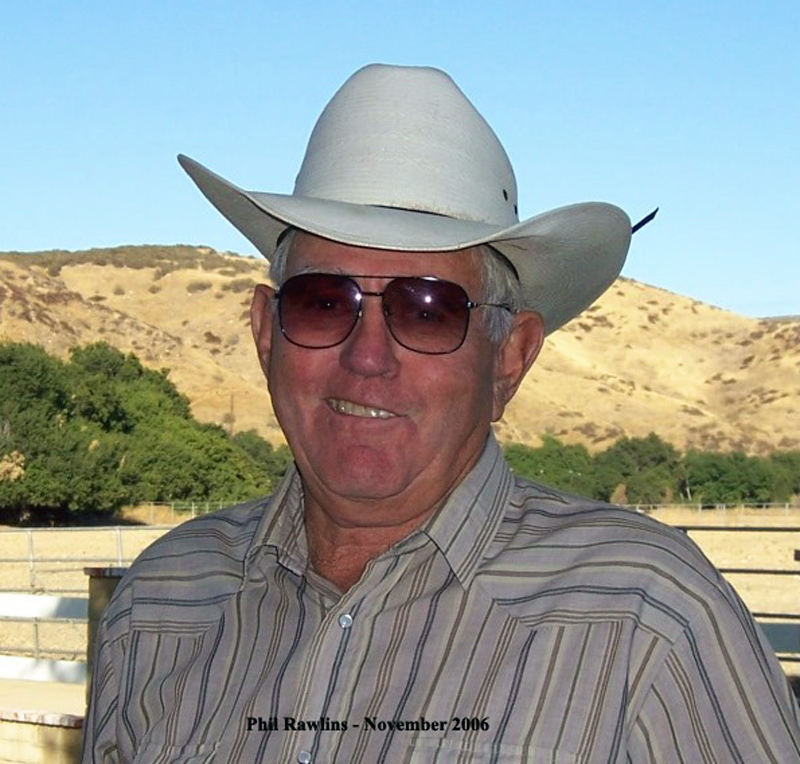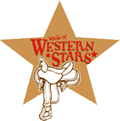Webmaster's note.
Phil Rawlins died May 29, 2009, one day after his 79th birthday. That same year, a section of his Placerita Canyon property was transfered to the city of Santa Clarita. It
became a part of the city's Quigley Canyon Open Space.
 Since 1969, Phil Rawlins has called Placerita Canyon home, living on the edge of paradise, this side of Fox's Pasture. While Phil is thought of today as a calf roper and bulldogger cowboy, what you may not know is that for 52 years, he had great success in the motion picture business. Saddle up for the ride.
Since 1969, Phil Rawlins has called Placerita Canyon home, living on the edge of paradise, this side of Fox's Pasture. While Phil is thought of today as a calf roper and bulldogger cowboy, what you may not know is that for 52 years, he had great success in the motion picture business. Saddle up for the ride.
The Beginning
Born in Glendale, California 76 years ago, Phil went to school at Riverside Drive Elementary School (this writer's alma mater), North Hollywood Jr. High, and North Hollywood High School, where he played basketball. While living with his family near Magnolia and Coldwater in North Hollywood, he got his first horse at nine years of age, and has fond memories of riding around the San Fernando Valley's alfalfa fields and dirt roads. While in high school he started roping, in fact on weekends roping near the intersection of Saticoy and Woodman Avenues with Ben Johnson, another calf roper.
After high school, Phil attended Pierce College where he started the rodeo team which, after their first big win in Arizona competition, put Pierce on the rodeo map. Phil has been roping ever since. After he turned 40, he joined the Senior Pro Rodeo Circuit Association (PRCA). In fact, at the age of 57 he made the PRCA Sierra Finals in Calf Roping. Balancing his career with the rodeo circuit, he competed in 35 to 40 rodeos a year, primarily in California though he also successfully participated at Calgary, Cheyenne, Cow Palace, Pendleton and Salinas events.
Roll Those Credits Now
Meanwhile, back on the set, for the first 10 years of his career, Phil was a stuntman. He doubled for Clint Eastwood in "Rawhide," rode shotgun on the stagecoach in "Gunsmoke," as well as doubling for Randolph Scott, Robert Ryan, and Don Murray, the latter in "Bus Stop" which featured Marilyn Monroe.
After 10 years, he was lucky to get into production first as Second Assistant Director in "Fury" (remember Fury?), and then primarily as First Assistant Director at Warner Brothers Studios. Credits at that time include "Hawaiian Eye," "Cheyenne," "Bronco" and "77 Sunset Strip." For two seasons, he served as Director on "F Troop," the first year as Assistant Director until directing the last episode of the first season, liking it so much, he directed half of the second year. He then directed "Adam 12" and "High Chaparral."
After the stint at directing, Phil decided he'd rather go back into Production where he served as Production Manager for "Coma," "Star Trek" motion picture, "Gremlins" 1 & 2. He is proud of the fact that "Gremlins 1" had been made for $10 million and grossed $250 million. During this period of time, he also did second unit production in Spain on "Wind of the Lion" with Sean Connery.
Recollections about Phil
Placerita's own Laurene Weste, Santa Clarita City Mayor, recalls during the 1970's when she owned and operated a country general store in Newhall that "tall, handsome, cowboy director" Phil would stop by and chat over the day's film shoots and rodeo events. She has fond memories of Phil's regular chats with her beloved father Rudy Friml, himself legendary in musicals for over 50 years (i.e. "Sound of Music," "Music Man" "Paint Your Wagon").
She also remembers that Phil would ride over and practice team roping with her neighbor, the late Emery Kauzlarich, another very famous canyon resident known for his rodeo skills. Phil, Emery and the boys would regularly patrol Newhall Creek, a patrol that is now sorely missed and soon to be resurrected.
"Legends like Phil are cherished treasures of our community, just like Bill Hart and Gene Autry were in time's past, creating the mystique of Santa Clarita's connection to the western way of life and the movie industry," Laurene proudly says.
The Move to Placerita
In 1969, after living in the San Fernando Valley, including a year at the Equestre Inn in Burbank where he kept his horse in the under parking lot stable, Phil moved to Placerita Canyon. He learned about the Canyon from local Newhall pioneer Fox O'Callahan, a famous rodeo cowboy who also worked in the motion picture business. To this day, Phil maintains that Fox should have a star on Newhall's Western Walk of Stars. It was from Fox that he purchased 10 acres behind his current home, which included an original cabin built in 1915, in which Phil lived until 1985. He purchased the front 10 acres from Beazer Homes, upon which he built his current home in 1985. The Rawlins home is most comfortable, and adorned with countless family photos, western art and memorabilia, as well as rodeo pictures and framed belt buckles awarded during his many years of competition.
 Family Man
Family Man
Phil is very happily married to his 2nd wife Fran, an international flight attendant, who he met in 1976 while flying to Boston. Five years later, they married, and eventually moved to the new custom home. He has two sons, film editor Clay Rawlins who lives in Castaic, and cameraman Lex Rawlins of Acton, as well as three beautiful granddaughters named Kylie, McKenna, and Lacy.
In addition, Phil is most proud of his sister Lisa Rawlins, a Warner Brothers Vice President, who was instrumental in the creation of the State of California Film Commission, at his suggestion, during the term of Governor Deukmejian.
His Neighborhood and Fox's Pasture
Not much has changed since Phil moved to the end of Cleardale Avenue. A few new houses, and Saxonia Park turning into a church are just about it[1]. Beazer Homes' failed in an attempt to put houses next to him, and Phil was most supportive in the quest of Laurene Weste in securing Fox's Pasture for open space several. Fox used to turn cattle out in the area to eat the weeds, and in 1962, the year he didn't graze cattle, is when most of Placerita Canyon, including the original Gene Autry Melody Ranch, went up in flames. Phil is currently grazing three roping steers in a fenced area next to his roping arena. His several horses graze in pastures in the picturesque view from his home.
One of Phil's other neighbors is the LA Aqueduct also featured in this edition. He is very impressed by this long pipe which traverses the canyon about a mile from his home. How Mulholland got this water all the way over to Los Angeles without pumps, using only horses, mules and manpower continues to amaze him.
In designing his home, Phil made sure that the view from the kitchen window included the tranquility and beauty of pristine Fox's Pasture, his only message is to keep the gate closed, to keep out the illegal dumping. Respect the land, keep it clean, and feel welcome.
One of Phil's Favorite Rodeo Arenas
Not far from Placerita Canyon is the venerable Saugus Stadium located on Soledad Canyon. Interestingly, the stadium belonged to Hoot Gibson following its purchase in 1930 from Roy Baker, brother of shoe magnate C.H. Baker. According to Phil, it was designed to resemble the stadium which houses the Pendleton Roundup. Hoot's wife was actress Sally Eiler who, when he made her Queen of the Rodeo, galloped around the arena holding up a stiff rope. What's special about Saugus Stadium to Phil is it was here that he attended his very first rodeo as a kid, and later won a major calf roping event there. The Gibson Ranch became the Bonelli Ranch, and eventually the Saugus Stadium. Participating in the annual Saugus Rodeo held the last weekend in April was a yearly tradition for Phil until the late 1950's when the Stadium transitioned over to hot rod races, and now is known for the Saugus Swap Meet.
Interestingly, about two years ago, Hoot Gibson's saddle with an original 1930's Saugus rodeo insignia was purchased on EBAY by the Santa Clarita Valley Historical Society for over $5000. This special saddle is now proudly on display back home in Newhall at the Historical Society, preserving yet another link to Saugus Stadium's colorful past.
Don't Change a Thing
Although Phil has been just about everywhere in the world, there is no place he would rather be than Placerita Canyon. His only wish is not to change it. In terms of future development on the perimeters of our canyon, if anything must happen at all, ideally he would like to see nothing less than lots the size of those in Palomino Estates. Lastly, Phil feels most fortunate to have kept two careers going at the same time, a rodeo career and a motion picture career. "If there is a hereafter, I want to come back as myself," says Phil.
And this writer says she certainly left with more than she had upon knocking on Phil's door.
1. Saxonia Park was located at 24912 Quigley Canyon Road, corner Cleardale. Rawlins lived at 21565 Cleardale.




